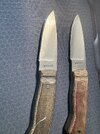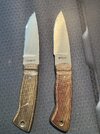I was sharpening a Wheeler 3 finger that had gotten dull using the Work Sharp Precision and noticed that the height of the bevel it put on was several times larger than the original edge.
What is the functional difference in the very small bevel that was originally on there and the new wider bevel I put on? Any tips or tricks for maintaining the factory edge height if it is a better edge?
It is extremely sharp now so I’m happy with that outcome.
Here is the resharpened knife on the left and a different Wheeler with the original thin bevel on the right.


What is the functional difference in the very small bevel that was originally on there and the new wider bevel I put on? Any tips or tricks for maintaining the factory edge height if it is a better edge?
It is extremely sharp now so I’m happy with that outcome.
Here is the resharpened knife on the left and a different Wheeler with the original thin bevel on the right.



